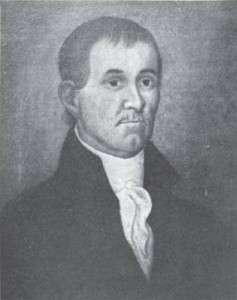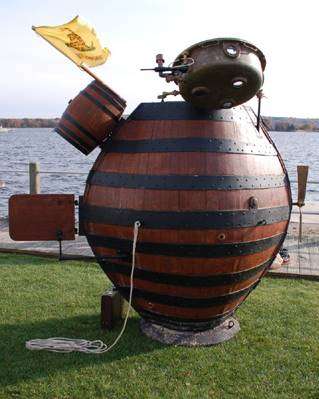New York Harbor — September 6, 1776, 11 p.m. At the foot of Whitehall Street in New York City, where the Staten Island Ferry departs the city today, two whaleboats slipped silently into the water under a moonless sky. Thus they launched the first military mission ever undertaken by a submarine. It was called the Turtle.
One of the most lethal and effective weapons of modern war started out that night as a wooden keg that looked like two huge turtle shells strapped together. And that’s what people called it: the American Turtle.
The 1st Turtle Mission
With only a few hours of experience navigating the submarine, the one-man captain/crew inside prepared for a preposterous mission. Ezra Lee, of Lyme, Conn., was to submerge the vessel under the water using the same basic water ballast system used today.
Once submerged in his airtight cocoon, he planned to take the submarine four miles into the harbor. He would use a propulsion system that consisted of oars and a treadle-powered screw propeller mounted on the bow of the ship. Then he would maneuver the tiny vessel aside the 64-gun frigate H.M.S. Eagle.
Nearly hemmed in on Manhattan, Continental Army Commander-in-Chief George Washington hoped the destruction of the Eagle, Admiral Richard Howe’s flagship, would help him hold the city.
The plan was straightforward. Using a screw that could be activated from inside the submarine, Lee would attach an explosive device and timer to the hull of the ship, pedal away and watch the ship explode.
On the night of the planned attack, the two whaleboats towed the American Turtle as near to the target as the men dared. With the help of the ship’s inventor David Bushnell, Lee sealed himself inside, flooded the ballast chamber and descended beneath the surface. He found the currents stronger than he expected. It would take two-and-a-half hours before he reached the Eagle, undetected.
The Science of Warfare
The idea of the Turtle was inspired by another discovery that Bushnell witnessed while a student at Yale. A group of scientists working with black powder found they could successfully detonate it under water. The men immediately understood the applications for this knowledge.
With war breaking out in 1775, Bushnell set about building a submarine to attack the British ships then blockading Boston Harbor. Working at shipyards near his home in Saybrook, Conn., Bushnell began perfecting the mechanics behind his boat. In 1775 or 1776, Bushnell approached George Washington with his plan.
Washington funded the development of the vessel and provided material support. He would later recount, however, that before the attack on the Eagle, he had his doubts.
Washington’s Doubts
“Although I wanted faith myself, I furnished him with money, and other aids to carry it into execution,“ Washington later wrote of the Turtle. “I then thought, and still think, that it was an effort of genius; but that a combination of too many things were requisite, to expect much success from the enterprise against an enemy, who are always upon guard.”
Though Bushnell tried to keep the device secret, the people of Lyme and Saybrook knew of them.
Loyalist sympathizers informed the British Navy about the development of the Turtle, though they had few specifics as to Bushnell’s progress.
By the time the Turtle was operational, 1775 had turned into 1776. The British Navy had been expelled from Boston and sailed to New York Harbor, where it moored in the North River. Bushnell changed his target to New York.
Technological Marvel
As Lee cranked his way through the waters of New York Harbor, he controlled an ingenious craft. Just seven feet long and six feet high, the submarine consisted of hollowed-out oak banded together with steel. It was sealed with cork and pitch, and topped with a brass cap fitted with an air exchange so fresh air could be drawn inside while the submarine was near the surface.
The brass cap – a precursor to the modern conning tower — had glass portals so the pilot could watch where he was going while on the surface. Once submerged, the pilot would use a barometer to determine his depth and a lead sounder attached to a cord to sense the sea bottom. He also used a compass illuminated by foxfire, produced in certain decaying fungus. With a pump to draw in and expel ballast water, the craft could raise and lower itself to whatever depth the pilot chose.
The Turtle Had Firepower
The weaponry was no less complex. The Turtle carried three bombs, each with a timing mechanism developed by Bushnell and his colleagues. One was set to go off six hours after being armed, one eight hours after arming and the third 12 hours. The sub was outfitted with a screw that was to be augured into the side of the target vessel. The explosives, carried on the outside of the submarine, could be detached from the sub and attached to the vessel by hanging them on the screw. The action of detaching them from the submarine would initiate the timers.
Benjamin Franklin, who consulted on the project, concluded that the explosives contained three times as much powder as needed to destroy the largest ship afloat.
Using a system of oars rigged to the top of the submarine and the treadle-powered prop, the submarine could reach three knots. Armed and ready, Lee had propelled himself next to the unsuspecting Eagle.
Change of Plans
Before Lee even entered the Turtle, the mission had already encountered a huge setback. Bushnell’s brother had originally been the designated pilot of the ship. He had made extensive training runs and used the intricate controls skillfully. Shortly before the mission, however, he fell ill – too ill to manage the exertions of powering the submarine.
Lee, who signed on to support the mission, was tapped to fill in just a few days earlier. He had little chance to train, but Bushnell – already exasperated with delays – wanted to wait no longer.
So, with light already showing in the sky, Lee arrived at the Eagle early in the morning of Sept. 7 after his two-and-a half hour journey underwater. He wasted no time in getting to work setting the explosives as he had practiced. But neither he nor Bushnell had anticipated the hull of the Eagle: It was sheathed in copper. The screws on the Turtle could not penetrate the hull.
After two tries, Lee, undoubtedly exhausted, decided he had to retreat. Making his way back across the harbor in the lightening sky, however, British officers observed him and put a boat in the water to chase him down.
The Great Explosion
With Lee pedaling and paddling furiously, the British gave pursuit. Fearing his capture, Lee released the charged explosives into the water in hopes of inflicting at least some damage. With his navigation equipment failing, Lee needed to keep surfacing to set his course.
The British grew suspicious of the odd craft they were pursuing. Suspecting they were being led into some sort of trap, they turned back. Lee was able to signal his comrades, who towed him back to land.
The charges Lee had set loose later exploded, sending columns of water surging into the sky. Franklin was correct in his estimation. The magnitude of the explosion astounded the British. As a precaution, they relocated their fleet outside the mouth of the harbor. And the first military attack by a submarine was in the history books.
The Turtle Sinks
The Americans tried two more times to use the Turtle, unsuccessfully. The British then sank the sub, though not in the water. They destroyed a vessel that carried it. Bushnell recovered it, but he attempted no more missions.
He turned his attention to developing mines that could be deployed in waterways. And he took part in the siege at Yorktown as a captain in the Corps of Sappers and Miners.
Lee went on to fight with Washington’s army in Trenton, Monmouth and Brandywine. At Brandywine, according to one story, the British shot away his sword handle and several balls penetrated his coat. He returned to Connecticut after the war and died in 1821 in Old Lyme.
A Curious Ending
Bushnell had a more curious ending. Following the war, he travelled to France. He attempted for many years to find backing for his submarine with the hope of improving it. But people viewed the submarine, at that time, as too experimental and not a likely success. Some even ridiculed the idea.
Frustrated by failure and low on money, Bushnell changed his name to Bush and moved to Georgia around 1795. A classmate helped him win a position as a schoolmaster, and he settled in Warrenton and practiced as a physician. For 40 years he lived there, his whereabouts unknown in Connecticut. He was only discovered upon his death when his will directed that a search should be made in Old Saybrook for any heirs.
The Turtle itself ended its life as scrap, its metal components used in the construction of clocks. Many replicas of the vessel have since been built. Though the submarine was not truly converted to a successful weapon until the mechanical age, people today view the Turtle as a military marvel.
This story about George Washington’s submarine was updated in 2022.





3 comments
http://m.youtube.com/watch?v=AIZdATkQNoo
[…] 13. Early Submarines: Cornelius van Drebel and The Turtle Scale model of the Turtle submersible Image Courtesy of New England Historical Society While many remember submarines as a staple of modern warfare, they actually were invented almost […]
[…] unusually inventive ever since David Bushnell invented a submarine for George Washington called The Turtle. Connecticut women – 44 of them – were among the 5,578 Connecticut inventors who obtained U.S. […]
Comments are closed.